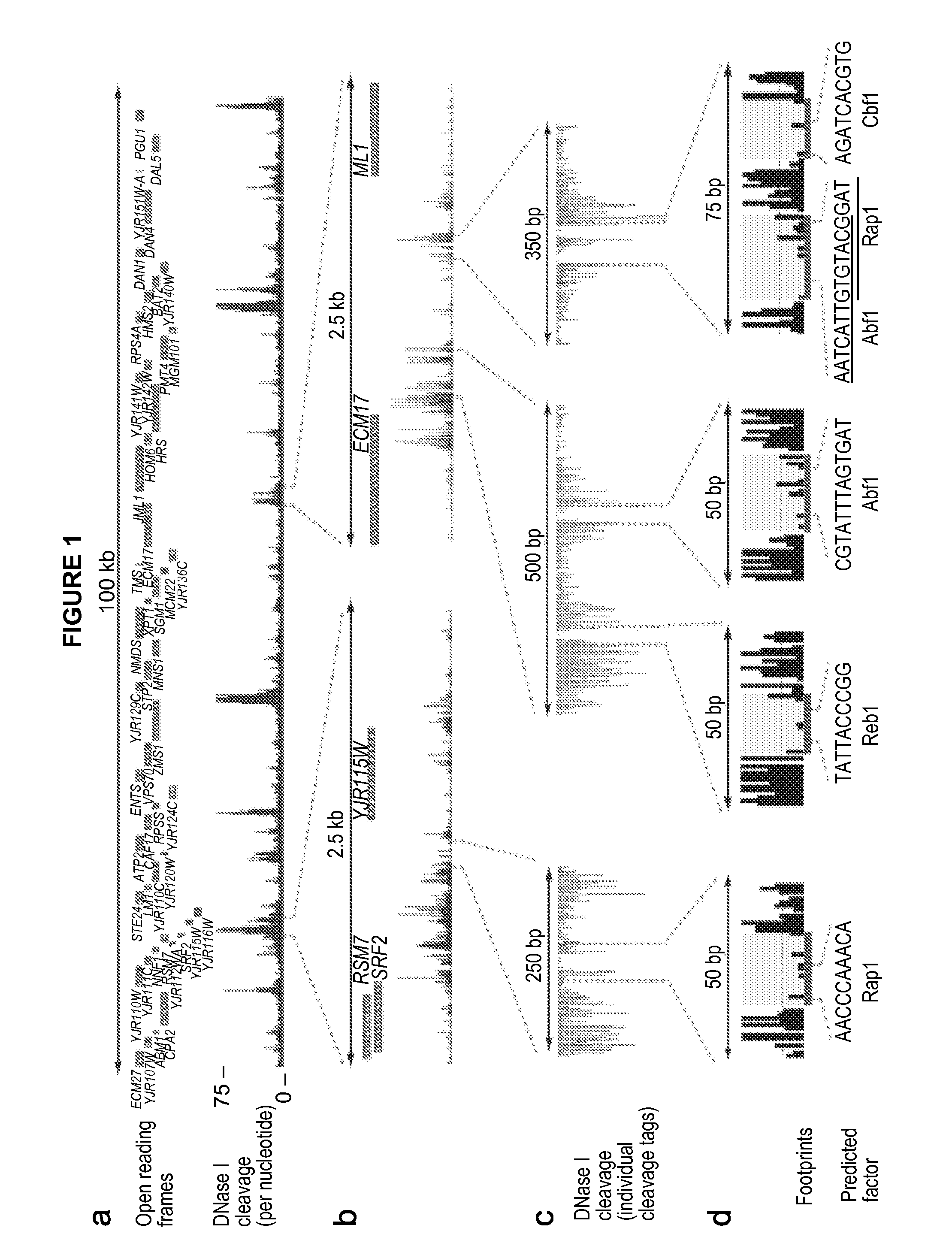Global mapping of protein-dna interaction by digital genomic footprinting
a technology of protein-dna interaction and global mapping, applied in the field of global mapping of protein-dna interaction by digital genomic footprinting, can solve the problems of not providing nucleotide-level resolution, laborious in practice, and particularly challenging
- Summary
- Abstract
- Description
- Claims
- Application Information
AI Technical Summary
Benefits of technology
Problems solved by technology
Method used
Image
Examples
example 1
[0131]The digital genomic footprinting strategy. To visualize regulatory protein occupancy across the genome of Saccharomyces cerevisiae, the inventor coupled DNase I digestion of yeast nuclei with massively parallel DNA sequencing to create a dense whole-genome map of DNA template accessibility at nucleotide-level. The inventor analyzed a single well-studied environmental condition, yeast a cells treated with the pheromone α-factor, which synchronizes cells in the G1 phase of the cell cycle. The inventor isolated yeast nuclei and treated them with a DNase I concentration sufficient to release short (8. Because each end of the released DNase I ‘double-hit’ fragments represents an in vivo DNase I cleavage site, the sequence and hence genomic location of these sites can be readily determined by sequencing (Methods, below).
[0132]Using an Illumina Genome Analyzer, the inventor obtained 23.8 million high-quality 27 bp end-sequence reads that could be localized uniquely within the S....
example 2
Human
[0188]Method for Agilent Array Capture (Based on K562 Globin Array Experiments) Isolation of DNase I fragments
[0189]Isolation of double hit DNase I fragments was carried out through a sucrose step gradient set up by a Biomek (Beckman Coulter, Inc.). 9 mls of a 40% sucrose solution (20 mm Tris-Cl (ph 8.0), 5 mM EDTA, 1 M NaCl) was dispensed slowly (˜9.7 ul / s) into the bottom of the tube, followed by 9 mls of a 30, 20 and 10% sucrose solution for each successive layer in a 25×89 mm Beckman, Ultra-Clear Tubes (Beckman Coulter Inc.,).
[0190]In vivo DNase I treated K562 DNA (8 million nuclei) was layered onto the sucrose step gradient and ultracentrifuged for 24 h at 25,000 r.p.m. at 16 C in a SW21 swinging bucket rotor Beckman LE-80 Ultracentrifuge 77,002 g. Fractionation was performed using a Biomek. Successive 1 ml fractions were removed from the top at ˜9.7 ul / s and dispensed into a 96 deep well plate. DNA fragment size in the fraction was determine by combining 8 ul from each fr...
example 3
[0196]
TABLE 4No. footprints detected in five human cell lines as accomplished by deep-sequencing of hotspots. Core footprints are disjoint and the following statistic was optimizedat each base.Footprint Statistic = (C + 1) / L + (C + 1) / RC = mean tag counts in core footprintL = mean tag counts in left flanking regionR = mean tag counts in right flanking regionFor these analyses:Each of L and R has a range of 3-10 bpsC has a range of 6-40 bpsTag Levels were:GM06990.DS7748148,665,129HepG2.DS7764165,417,704K562.DS9767158,355,647SKNSH.DS8482187,549,355TH1.DS7840175,837,038FDR Method Randomly shuffle tags within each hotspot.FDR = E(FP / (FP + TP))~E(FP) / E(FP + TP)~(#randoms / #observes)No. Footprints DetectedFDR.0p001FDR.0p005FDR.0p01FDR.0p05GM06990.DS7748282,214398,864406,722631,300HepG2.DS7764302,723404,148459,937611,400K562.DS9767353,808491,785569,195790,064SKNSH.DS8482364,464501,704571,101764,049TH1.DS7840309,045439,849513,318715,579FDR vs. StatisticFDR.0p001FDR.0p005FDR.0p01FDR.0p05GM069...
PUM
| Property | Measurement | Unit |
|---|---|---|
| length | aaaaa | aaaaa |
| average frequency | aaaaa | aaaaa |
| frequency | aaaaa | aaaaa |
Abstract
Description
Claims
Application Information
 Login to View More
Login to View More - R&D
- Intellectual Property
- Life Sciences
- Materials
- Tech Scout
- Unparalleled Data Quality
- Higher Quality Content
- 60% Fewer Hallucinations
Browse by: Latest US Patents, China's latest patents, Technical Efficacy Thesaurus, Application Domain, Technology Topic, Popular Technical Reports.
© 2025 PatSnap. All rights reserved.Legal|Privacy policy|Modern Slavery Act Transparency Statement|Sitemap|About US| Contact US: help@patsnap.com



